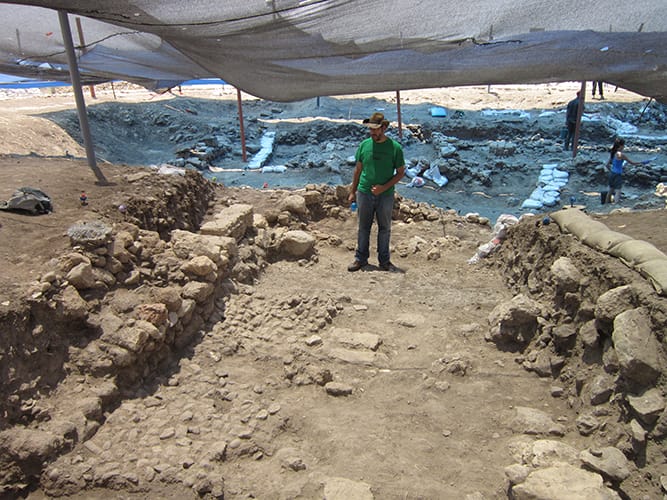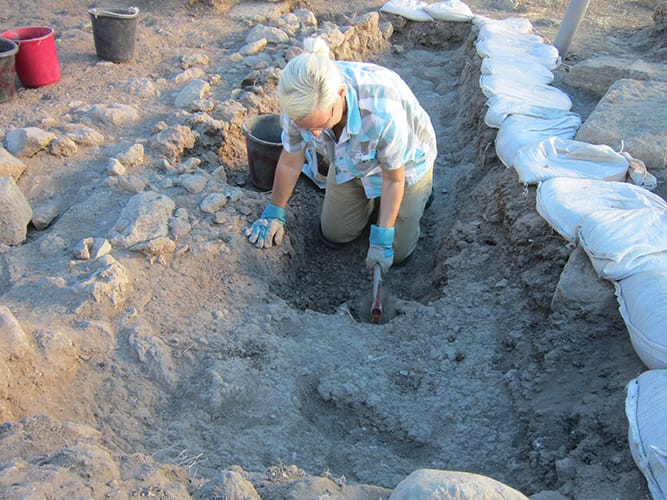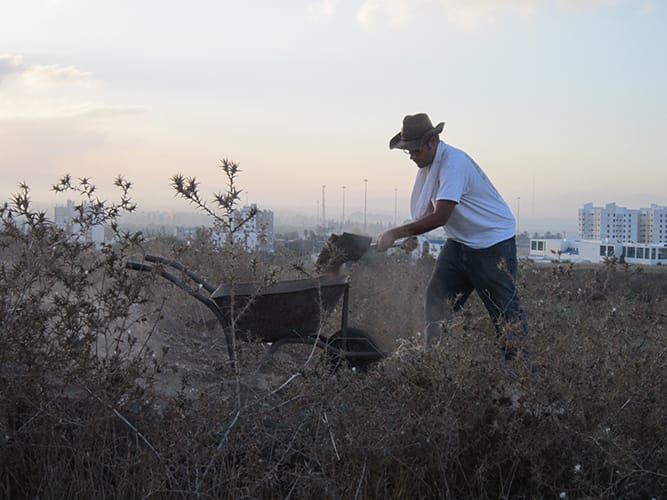Archaeological Excavation in Akko Uncovers Conflicting Realities

Digging for the Truth
It was a warm afternoon in the countryside when 7-year-old Nicholaus Pumphrey and his dad went on one of their “expeditions.” It was really a chance to walk and talk, and maybe look for Native American artifacts, mostly arrowheads. At a likely spot when the talking was finished, Nick started digging. He had done it before, he knew about how far down to dig, he could smell and feel the soil as it filtered through his hands. Finally, he heard the familiar sound of metal hitting stone that told him he had something. It was an arrowhead; another one to add to his collection. But, it was never routine. To him it was another link in a chain that stretched back hundreds, maybe thousands of years to another person who had stood where he stood and dropped an arrowhead. It was always exciting.
“I remember growing up in Iron City, Georgia, and how I looked forward to digging up arrowheads with my dad,” Pumphrey recalls. “I was always excited, no matter how many times we found one. And, I’m still excited today when I dig up a piece of pottery or other artifact. But, things are more complex than those days,” continued Pumphrey. “It’s archaeology, the pure science that I love, but it gets complicated with politics, economics, religious beliefs, and culture. I wonder sometimes not what we are digging for, but who we are digging for.”
Pumphrey continues to ask himself that question as part of the School of Arts & Humanities’ archaeological dig in Akko, Israel, over the past three years. Even as he pursues his PhD in religion, Pumphrey has learned how difficult it can be to work in a site that has been continuously occupied for thousands of years by multiple religions and cultures. Mentioned by the pharaohs of Egypt, cited in the Old Testament, Akko is a city that saw the likes of Alexander the Great, the Roman Legions, the Byzantine Empire, the Muslim army of Khalid ibn al-Walid, the European Knights of the Crusades, and Napoleon.

“What’s so interesting and exciting is also what is so challenging about our site in Akko,” said Arts & Humanities Dean Tammi Schneider and leader of the Akko dig. “You’re touching something ancient that can help us better understand human civilizations for thousands of years, and yet it also has enormous implications for the inhabitants of Akko today. This land has deep roots for Jews, Muslims, Christians, and Baha’i. It’s a World Heritage site that has to be preserved, and yet it still needs to be developed for tourism to support the lives of those living there today.”
Add to the archaeological preservation concerns, the cultural and religious concerns, the complexity of modern Israeli politics with the Israeli Antiquities Authority, the Akko city planners, and local property owners, you begin to see the labyrinth of interpretations that can be placed on every item that is brought out of the dig. Every item is seen as another example of who has the rights to this land.

The strongest example of this tangle of competing interests was the earliest excavations done at the Akko site. Begun in the 1970s by a leading figure in archaeology, despite the lack of physical evidence, the published reports of the excavations seemed to establish Akko as a site occupied by early Jewish settlers. This remained the accepted belief for decades. When CGU’s excavations began, the finds that were uncovered and analyzed showed no evidence for early Jewish settlement. There was, however, definitive proof from specific pottery found at the site for Greek occupation. Curiously, no mention of Greek pottery had been noted in the reports of the earliest work done. It came to light that the early Greek pottery had actually been found in the earliest digs. However, the decision had been made to omit that information from the initial excavation reports.
“We follow the strictest accepted protocols for the handling of the artifacts we discover,” said Pumphrey. “But, there’s no protocol in archaeology for handling the politics of everyone’s claim on the same piece of earth. More than once, Tammi has had to make her way through a maze of claims, and counter claims, and misinterpretations of what the site is actually telling us about Akko’s past. All of us students are involved in that, too; learning from that experience as well.”
Another example of claims and counter claims in the area is the mysterious overnight appearance of a statue of the French Emperor Napoleon at the Akko dig site in 2009. This year, the dig site of Tel Akko was renamed with new posted signs as Tel Napoleon. Why Napoleon? Pumphrey and Schneider explained that this is how history and politics and culture and sometimes myths are thrown together to create a new “truth” in modern-day Middle East. During Napoleon’s siege of Akko in 1799, the French newspaper, Le Moniteur Universel, published the text of a proclamation: “Bonaparte has published a proclamation in which he invites all the Jews of Asia and Africa to gather under his flag in order to re-establish the ancient Jerusalem.” Despite Napoleon’s attempt to gather more troops to his force, he went on to lose that battle.

In the 1940s, Napoleon’s words and intentions were revived again and interpreted by some to suggest he was intending to create a Jewish state in what was then Palestine. Scholars today have discredited that claim, but the former French Emperor’s intentions remain part of Akko’s culture today. “The appearance of a statue of Napoleon on Tel Akko, holding aloft an Israeli flag, was a message to all that ‘this is Israeli territory,’” said Pumphrey.
The students that traveled to the Akko dig site this past summer not only experienced the scholarly transdisciplinary realities of the dig, but a transformed curriculum that moved their education beyond the traditional archaeological concerns of excavating, treating, cataloging, analyzing, and publishing and into socio-political reality. “I’ve been on digs before,” noted Pumphrey. “I was on the Megiddo dig (the famed city of Armageddon) while studying for my MA in the Hebrew Bible at Vanderbilt. We had the typical concerns, but nothing nearly as complex and potentially controversial as this. I have learned so much from this experience.”

“At times, all these factors contesting for attention can be frustrating,” said Schneider. “But, we just keep digging, discovering, and learning more about the history of the Middle East and this ancient city. Many times my students ask me, ‘Who are we really digging for?’ I tell them you are digging for history, for knowledge; you’re digging for the truth.”
For video of the 2010 Akko dig, please click on the video below: